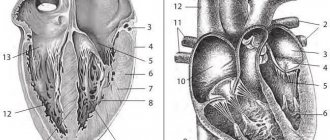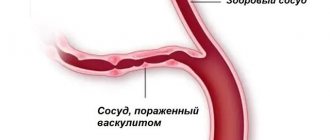Medicines for ischemic heart disease
A cardiologist may recommend drug therapy if lifestyle changes seem insufficient. Medicines are prescribed only by the attending physician. Most often, drugs are prescribed that reduce the risk of thrombosis (aspirin, Plavix). Statins can be prescribed long-term to lower cholesterol levels. Heart failure should be treated with drugs that improve the function of the heart muscle (cardiac glycosides).
- Aspirin
In those with no history of heart disease, aspirin reduces the likelihood of a heart attack but does not change the overall risk of death. It is recommended only for adults who are at risk of developing blood clots, where increased risk is defined as “men over 60 years of age, postmenopausal women and young people with a background risk of coronary artery disease (hypertension, diabetes or smoking).
- Antiplatelet therapy
Clopidogrel plus aspirin (dual antiplatelet therapy, DAAT) reduces the risk of cardiovascular events more than aspirin alone. These drugs are contraindicated in patients with a history of gastrointestinal ulcers or gastric bleeding. Antiplatelet therapy should be carried out for life.
- β-blockers
Adrenergic blockers reduce heart rate and myocardial oxygen consumption. Studies confirm an increase in life expectancy when taking β-blockers and a decrease in the incidence of cardiovascular events, including recurrent ones. β-blockers are contraindicated in case of concomitant pulmonary pathology, bronchial asthma, COPD.
- β-blockers with proven properties of improving the prognosis of coronary artery disease:
- Carvedilol (Dilatrend, Acridilol, Talliton, Coriol).
- Metoprolol (Betalok Zok, Betalok, Egilok, Metocard, Vasocardin);
- bisoprolol (Concor, Niperten, Coronal, Bisogamma, Biprol, Cordinorm);
- Statins
Drugs in this group reduce cholesterol levels in the blood by reducing its synthesis in the liver, or inhibit the absorption of cholesterol from food, affecting the causes of atherosclerosis. Medicines are used to reduce the rate of development of existing atherosclerotic plaques in the walls of blood vessels and prevent the formation of new ones. There is a positive effect on the degree of progression and development of symptoms of coronary heart disease, on life expectancy, and these drugs also reduce the frequency and severity of cardiovascular events, possibly helping to restore the lumen of the vessel. The target cholesterol level in patients with coronary artery disease should be lower than in persons without coronary artery disease and equal to 4.5 mmol/l. In blood tests, the target LDL level in patients with coronary artery disease should be no more than 2.5 mmol/l. Lipid levels must be measured every month. Main drugs: lovastatin, simvastatin, atorvastatin, rosuvastatin.
- Fibrates
They belong to a class of drugs that increase the antiatherogenic fraction of lipoproteins - HDL, with a decrease in which mortality from coronary artery disease increases. Used to treat dyslipidemia IIa, IIb, III, IV, V. They differ from statins in that they reduce triglycerides and can increase the HDL fraction. Statins primarily reduce LDL and do not have a significant effect on VLDL and HDL. Therefore, the maximum effect occurs with a combination of statins and fibrates.
- Nitroglycerin preparations
Nitroglycerin is the main drug that relieves chest pain in the heart area. Nitrates predominantly act on the venous wall, reducing the preload on the myocardium (by dilating the vessels of the venous bed and deposition of blood). The unpleasant effect of nitrates is a decrease in blood pressure and headaches. Nitrates are not recommended for use if blood pressure is below 100/60 mmHg. Art. Modern studies have proven that taking nitrates does not improve the prognosis of patients with coronary heart disease, that is, it does not lead to an increase in survival, and therefore are used as a drug to relieve symptoms of coronary artery disease. Intravenous drip administration of nitroglycerin can effectively combat the symptoms of angina pectoris, mainly against the background of high blood pressure numbers. Every patient with coronary artery disease should know that if taking nitroglycerin at home does not relieve chest pain, then it is necessary to call an ambulance, as a heart attack may have developed.
Treatment of coronary heart disease
Treatment is aimed at restoring normal blood supply to the myocardium and improving the quality of life of patients. Unfortunately, purely therapeutic treatments are not always effective. There are many surgical methods of correction, such as: coronary artery bypass grafting, transmyocardial laser myocardial revascularization and percutaneous coronary interventional interventions (balloon angioplasty, coronary artery stenting).
Selective coronary angiography is considered the “gold standard” in the diagnosis of obstructive lesions of the coronary arteries of the heart. It is used to find out whether the narrowing of the vessel is significant, which arteries and how many of them are affected, in what place and over what extent. Recently, multislice computed tomography (MSCT) with intravenous bolus contrast has become increasingly widespread. Unlike selective coronary angiography, which is essentially an x-ray surgical intervention on the arterial bed, and is performed only in a hospital setting, MSCT of the coronary arteries is usually performed on an outpatient basis using intravenous administration of a contrast agent. Another fundamental difference may be that selective coronary angiography shows the lumen of the vessel, and MSCT shows the lumen of the vessel, and, in fact, the wall of the vessel in which the pathological process is localized.
Depending on the changes in the coronary vessels detected during coronary angiography, various treatment methods may be offered:
Coronary artery bypass grafting is an operation that has been practiced for many years, in which the patient’s own vessel is taken and sutured to the coronary artery. This creates a path to bypass the affected area of the artery. Blood in a normal volume enters the myocardium, which leads to the elimination of ischemia and the disappearance of angina attacks. CABG is the method of choice for a number of pathological conditions, such as diabetes mellitus, trunk lesions, multivessel lesions, etc. The operation can be performed with cardiopulmonary bypass and cardioplegia, on a beating heart without artificial circulation, and on a beating heart with artificial circulation. Both the patient's veins and arteries can be used as shunts. The final decision on choosing one type of operation or another depends on the specific situation and the equipment of the clinic. Balloon angioplasty, once popular, has lost its relevance. The main problem is the short-term effect of the performed x-ray surgery. A more reliable and, at the same time, minimally invasive method of restoring and maintaining the normal lumen of the vessel is stenting. The method is essentially the same as balloon angioplasty, but a stent (a small transformable metal mesh frame) is mounted on the balloon. When inserted into the site of narrowing, the balloon with the stent is inflated to the normal diameter of the vessel, the stent is pressed against the walls and retains its shape constantly, leaving the lumen open. After installation of the stent, the patient is prescribed long-term antiplatelet therapy. During the first two years, control coronary angiography is performed annually. In severe cases of obliterating atherosclerosis of the coronary arteries, when there are no conditions for CABG and x-ray surgery, the patient may be offered transmyocardial laser revascularization of the myocardium. In this case, improvement in myocardial blood circulation occurs due to blood flow directly from the cavity of the left ventricle. The surgeon places a laser on the affected area of the myocardium, creating many channels with a diameter of less than 1 millimeter. The channels promote the growth of new blood vessels through which blood enters the ischemic myocardium, providing it with oxygen. This operation can be performed either independently or in combination with coronary artery bypass grafting. After eliminating aortocoronary stenosis, the quality of life significantly improves, the ability to work is restored, the risk of myocardial infarction and sudden cardiac death is significantly reduced, and life expectancy increases. Currently, the diagnosis of IHD is not a death sentence, but a reason for active action to choose the optimal treatment tactics that will save life for many years.
How to get treatment at the Scientific Center named after. A.N. Bakuleva?
Online consultations
Prevention
Up to 90% of cardiovascular diseases can be prevented by avoiding established risk factors. Prevention includes adequate exercise, reducing obesity, treating high blood pressure, eating a healthy diet, lowering cholesterol levels and stopping smoking. Medicines and exercise are about equally effective. High levels of physical activity reduce the risk of coronary heart disease by approximately 25%. In diabetes, tight blood sugar control reduces heart risk and other problems such as kidney failure and blindness. The World Health Organization (WHO) recommends "low to moderate alcohol consumption" to reduce the likelihood of developing coronary heart disease, while excessive consumption is very dangerous for the heart.
Classification
Currently, a version of the taxonomy of IHD has been adopted, which assumes the presence of the following forms:
- Sudden death from coronary events (eg, cardiac arrest).
- Angina pectoris. There are stable (manifestations do not change over time), new-onset (duration less than 2 months) and unstable (progression of clinical symptoms).
- Myocardial infarction is a necrotic transformation of the heart muscle.
- Sclerotic changes.
- Any disturbances in rhythm and impulse conduction.
- Circulatory failure.
For ease of diagnosis, myocardial necrosis and unstable angina are combined under the common term acute coronary syndrome.
Rules for taking nitroglycerin
As part of first aid for an angina attack, you can use both tablets (to relieve an attack outside the home) and drops. The medicine is dropped onto a piece of sugar, which is placed under the tongue and wait until it dissolves. Check the dosage with your doctor, but remember: you cannot take more than 3 tablets (drops) in 15 minutes.
You may feel dizzy, because the effect of the medicine is to dilate blood vessels and reduce pressure. Therefore, before taking, take a comfortable position, sitting or lying down.
Expert advice
The nervous system plays an important role in regulating the activity of the heart and blood vessels. In the stronger half, the activity of the sympathetic department is expressed, in women - the parasympathetic. As a result, men are less likely (2-3 times) to experience rhythm disturbances and thromboembolic complications, leading to the clinical picture of acute coronary syndrome. That is why I strongly recommend that patients first of all normalize their psycho-emotional state.
Women get sick at a later age. The pathology is always severe and has many irreversible changes in all vessels of the body (diffuse atherosclerosis, arterial hypertension, decreased elasticity of arterial walls), more often leading to death from complications and conditions after fatal hemodynamic disorders.
Female representatives during menopause and postmenopause are characterized by the following features:
- the appearance of ischemia (latent) at night and satisfactory health during the day;
- a rare manifestation of pathology with an acute violation of the blood supply to the heart muscle;
- frequent silent myocardial ischemia, which can only be diagnosed with Holter ECG monitoring.
Signs of an angina attack
Since the vessels supplying blood to the heart are narrowed due to atherosclerotic plaques, only a small physical or emotional stress is enough for the heart muscle to feel a lack of oxygen and nutrients. At this time, lactic acid is produced in the tissues, which causes pain.
If, after you have worked physically or been over-excited, you experience heart pain, know that these are the first signs of illness. As it develops, less and less stress will be required to cause an attack. In severe cases, signs of angina appear when walking at an average pace for a distance of 200 meters or climbing one floor.
Diagnostics
An electrocardiogram (or echocardiography) at rest is NOT a method for diagnosing coronary artery disease. Sometimes these methods, however, make it possible to diagnose or detect coronary artery disease, for example, if signs of a previous myocardial infarction can be detected, or if they are performed against the background of chest pain.
Holter monitoring (ECG monitoring) also does not serve as a method for diagnosing coronary artery disease, although this method is used unreasonably widely for this purpose. ST segment depressions that are detected by Holter ECG monitoring are often nonspecific (i.e., false), especially in women. Holter monitoring only allows you to identify
The main method for diagnosing ischemic heart disease is stress testing.
. The main types of stress tests are: ECG tests with exercise and stress echocardiography, that is, echocardiography performed during exercise (or immediately after its completion) or against the background of the administration of drugs that increase heart function (for example, dobutamine). Myocardial scintigraphy (isotope study of the heart under stress) in Russia is performed in only a few centers and is practically inaccessible.
Based on the results of stress tests, a decision is made whether to refer the patient for coronary angiography. It is almost never necessary to begin the examination with coronary angiography. This is the best method to visualize (examine) lesions of the coronary arteries (atherosclerotic plaques), but coronary angiography often cannot assess their functional significance (whether they cause myocardial ischemia or not).
How to relieve an angina attack at home?
If an attack occurs while you are lying down, you need first aid. First of all, they helped you sit down and lower your legs down. Unbutton your collar, ask them to open a window in the house, apartment, or other room where you are and take nitroglycerin.
If you feel weak, pale, or have cold sweats, measure your blood pressure. If it is reduced, there is no need to take nitroglycerin. In this case, it is better to relieve the attack with aspirin. But the effect of validol is causing controversy in the world of medicine: doctors are increasingly inclined to believe that it is ineffective.
To provide effective first aid during an angina attack, always keep baralgin, sedalgin, and analgin in your first aid kit. If you have symptoms such as headaches, take one of these medications. For elevated heart rates, anaprillin is recommended.






